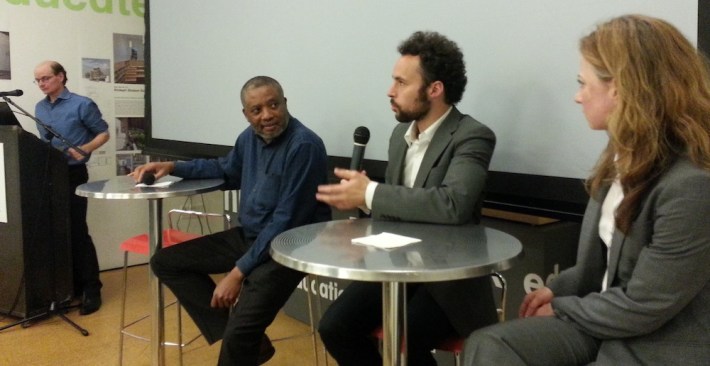
Cities and towns have been leading the charge for safer streets, incorporating design elements like protected bike lanes and sidewalk extensions. But design guidance from state highway officials often gets in the way when agencies don't have the technical or political heft to deviate from "the rules" that have long held sway in the field of street engineering. Last night, a panel of experts discussed how progressive best practices can be codified and included in the guidelines that shape decisions about street design across the nation.
The panel at the AIA-NY Center for Architecture, sponsored by the Congress for the New Urbanism's New York chapter and moderated by NYC DOT Policy Director Jon Orcutt, featured David Vega-Barachowitz of the National Association of City Transportation Officials, Laura MacNeil of Sam Schwartz Engineering, and Norman Garrick, a University of Connecticut civil engineering professor.
"You can't ignore the triumvirate of the Green Book, the Highway Manual, and the MUTCD," Vega-Barachowitz said, listing the dominant street design guidelines produced by the American Association of State Highway Transportation Officials and the Federal Highway Administration. These documents, which many transportation engineers rely upon when making decisions, are often faulted for emphasizing motor traffic throughput instead of creating safe, pleasant places that serve everyone who uses the street.
In recent years, forward-thinking planners and engineers have started to produce a new generation of design guidance. In 2006, Garrick worked with CNU and the Institute of Transportation Engineers to produce a set of standards that would be compatible with the existing highway-focused guidance while still meeting the needs of town centers and urban areas.
The engineers and planners who worked on the project first met in 2005. "I'll never forget that meeting. There was a lot of shouting," Garrick said. "We didn't even have the same language to discuss what we needed to discuss." Despite the initial divisions, the end product has been used by many engineers who trust ITE's imprimatur.
But this "context-sensitive" approach has its limitations. "A lot of times that just means slap down trees in the median, as opposed to reallocate space," Vega-Barachowitz said.
At the same time, cities across the nation have been adopting best practices from other countries. Finding no American guidance for what they were trying to do and running into roadblocks with state DOTs, transportation departments in larger cities began to develop their own street design manuals. New York released its manual in 2009, followed by Los Angeles in 2011, Boston in 2012, and Chicago just this month.
The city manuals include engineering guidance for features that have now become standard components of many city streets, such as protected bike lanes, parklets, plazas, and bus lanes. As these guides gained attention, NACTO, chaired by New York City DOT chief Janette Sadik-Khan, quickly began working to meld them into a new national standard that could operate parallel to the auto-centric AASHTO guidance.
In 2011, NACTO released its Urban Bikeway Design Guide, which helps engineers and planners create designs for protected bike lanes and other bike facilities that had until then been "non-standard." NACTO's guide differed not just in philosophy from AASHTO, but also in structure. The new guide relied heavily on annotated diagrams and illustrations to convey how facilities should be designed, in contrast with the text-heavy, prescriptive AASHTO manual.
That same year, US DOT Secretary Ray LaHood endorsed NACTO's guide. With a coalition of city transportation officials and the transportation secretary backing the new manual, NACTO hoped it could overcome concerns about legitimacy and liability that had kept engineers from pursuing newer designs. Vega-Barachowitz noted that often, bikeways are only deemed to be safe if there is a reviewed standard backing them. "Something like the NACTO guide does provide a permission slip," he said, "for the more innovative engineers."
For NACTO, the bikeway guide is the beginning, not the end. This fall, it will release its Urban Street Design Guide, providing a national manual addressing the entire spectrum of multi-modal street designs, not just bike lanes.
In the meantime, MacNeil added, America Walks has joined forces with Sam Schwartz Engineering to translate many of the principles found in the street design guides to a wider audience, including advocates and elected officials. The result is the "Steps to a Walkable Community" guide and companion website, so people interested in better streets know what to ask for when talking with planners and engineers.
But even as design guides are drafted and manuals for a wider audience disseminate the information, there is still more work to do. Garrick mentioned the guidelines behind speed regulation on most streets. Typically, speed limits are set at the road's "design speed" -- engineers simply determine how fast drivers will travel on the street (its "design speed"), and set the speed limit based on that. No consideration is given to the appropriate vehicle speed for the safety of pedestrians and cyclists.Instead, Garrick advocated for the concept of "target speed," where a desired speed is set, and the road is then designed to achieve that target.
"The relationship between design speed and target speed is very similar to the relationship between parking minimums and parking maximums," he said, with design speed setting a floor, but target speed setting a ceiling.
As the engineering policy efforts continue, best practices that are already in use must reach a broader audience. "We can't use the 20th century playbook as we move further into the 21st century," Orcutt said, noting that these innovations must spread beyond cities and towns. "We need to get them adopted by the federal government and the states."





